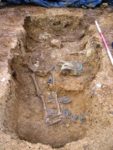 The unique funerary furnishings of a late Iron Age warrior found in West Sussex will go on display for the first time at Chichester’s Novium Museum in January 2020. The grave was discovered in 2008 during an excavation in advance of a new housing development in North Bersted, near Bognor Regis, West Sussex. Archaeologists had found evidence of occupation — boundary ditches, postholes, building remains — from the Bronze Age through Roman times, but the grave was entirely isolated, not part of a settlement or cemetery. It was discovered just 16 inches beneath the surface.
The unique funerary furnishings of a late Iron Age warrior found in West Sussex will go on display for the first time at Chichester’s Novium Museum in January 2020. The grave was discovered in 2008 during an excavation in advance of a new housing development in North Bersted, near Bognor Regis, West Sussex. Archaeologists had found evidence of occupation — boundary ditches, postholes, building remains — from the Bronze Age through Roman times, but the grave was entirely isolated, not part of a settlement or cemetery. It was discovered just 16 inches beneath the surface.
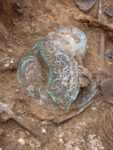 He was buried in supine position orientated northwest to southeast. Aligned at the end of the grave above his head were three large intact pots. Analysis of the pottery, which was new when buried and was probably made in Normandy, dates the grave to 50 B.C. Against his right side were a bronze shield boss, bronze helmet, a spearhead, a sword, deliberated reheated and bent as a ritual “decommissioning,” its scabbard and two sheets of elaborate bronze latticework.
He was buried in supine position orientated northwest to southeast. Aligned at the end of the grave above his head were three large intact pots. Analysis of the pottery, which was new when buried and was probably made in Normandy, dates the grave to 50 B.C. Against his right side were a bronze shield boss, bronze helmet, a spearhead, a sword, deliberated reheated and bent as a ritual “decommissioning,” its scabbard and two sheets of elaborate bronze latticework.
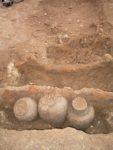 Iron bars and pieces therefrom were found overlying the grave crosswise. These are the remains of iron hoops which bound the deceased’s coffin and an addition iron-framed structure that was placed on top of the coffin. No remains of the wood from this coffin were discovered.
Iron bars and pieces therefrom were found overlying the grave crosswise. These are the remains of iron hoops which bound the deceased’s coffin and an addition iron-framed structure that was placed on top of the coffin. No remains of the wood from this coffin were discovered.
At first archaeologists thought the bronze latticework may have been part of the shield decoration as they were too big to be cheek-pieces for the helmet, but additional study found that it was actually a headdress, a ceremonial modification for a military helmet. In its day, the headdress would have gleamed like gold and been adorned with plumes of horse hair.
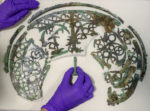 Nothing comparable to this grave has been found anywhere else in Britain. The bronze headdress is unique, and the sword is of a type entirely unlike the ones in the British Isles of the period.
Nothing comparable to this grave has been found anywhere else in Britain. The bronze headdress is unique, and the sword is of a type entirely unlike the ones in the British Isles of the period.
The remains shifted after deposition, but not due to interference with the grave which was undisturbed. The skull was found left of the body and the left humerus had shifted a foot and a half away from the scapula. These shifts could have been caused by the weight of the shield and other bronze pieces after the body had begun to decompose, or he may have been propped up on a pillow, now rotted away.
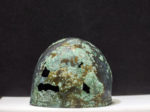 The skeleton was not in good condition. The surviving bone was soft and brittle, and the cancellous bone (the spongey type of bones found in the vertebrae, ribs, pelvis, hands and feet) was to all intents and purposes gone, extant only as stains in the soil. That soil was lifted for excavation in the laboratory in the hope of finding bone fragments; there weren’t any. The left side of the lower body was in the best state of preservation. The green staining explained why: the bronze of the artifacts he was buried with had helped preserved the bone it touched.
The skeleton was not in good condition. The surviving bone was soft and brittle, and the cancellous bone (the spongey type of bones found in the vertebrae, ribs, pelvis, hands and feet) was to all intents and purposes gone, extant only as stains in the soil. That soil was lifted for excavation in the laboratory in the hope of finding bone fragments; there weren’t any. The left side of the lower body was in the best state of preservation. The green staining explained why: the bronze of the artifacts he was buried with had helped preserved the bone it touched.
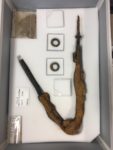 Even with the damage to the remains, osteological analysis determined that the man was about 5’4″ tall and was between 30 and 45 years old when he died. He experienced hardship when he was a boy — grooves on his teeth are evidence of childhood malnutrition or an acute illness like high fever — but his early challenges did not keep him from living an extremely active life as an adult. Strong muscle and ligament attachments on the legs indicate habitual horse riding and on the right humerus indicate his right arm was far more developed than his left. Given the grave goods, this is likely the result of extensive weapons training and use. There was no evidence of trauma, healed or perimortem on any surviving part of his skeleton. Fun fact: he had no wisdom teeth. Not removed or lost; they never existed. It’s a genetic thing.
Even with the damage to the remains, osteological analysis determined that the man was about 5’4″ tall and was between 30 and 45 years old when he died. He experienced hardship when he was a boy — grooves on his teeth are evidence of childhood malnutrition or an acute illness like high fever — but his early challenges did not keep him from living an extremely active life as an adult. Strong muscle and ligament attachments on the legs indicate habitual horse riding and on the right humerus indicate his right arm was far more developed than his left. Given the grave goods, this is likely the result of extensive weapons training and use. There was no evidence of trauma, healed or perimortem on any surviving part of his skeleton. Fun fact: he had no wisdom teeth. Not removed or lost; they never existed. It’s a genetic thing.
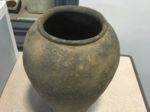 His origins are unclear. He may have come from eastern England and fought in Gaul, or he may have been a Gaul who ended up in Britain. The design of the headdress is distinctly Celtic. That and the Norman pottery points to him having spent time in Gaul. It’s possible the warrior made his way to Britain from the continent as part of a Roman contingent or as part of the Gallic anti-Roman resistance. Or both at different times, for that matter.
His origins are unclear. He may have come from eastern England and fought in Gaul, or he may have been a Gaul who ended up in Britain. The design of the headdress is distinctly Celtic. That and the Norman pottery points to him having spent time in Gaul. It’s possible the warrior made his way to Britain from the continent as part of a Roman contingent or as part of the Gallic anti-Roman resistance. Or both at different times, for that matter.
In Book 4 of Commentarii De Bello Gallico, Julius Caesar claims that Britons had consistently sent support to the Gauls during the Gallic Wars, and that therefore he was going to put a fleet together to just check things out across the channel. Ask a few questions here and there, look around, you know, sort of get the lay of the land. Backed by a couple of legions and as many ships as he could lay his hands on, of course. When the Britons caught wind of his plans they sent ambassadors to beg Caesar for mercy in advance, “to promise that they will give hostages, and submit to the government of the Roman people.” Ever magnanimous, Caesar agreed and sent one of his top men, the Belgic chieftain Commius, whom he had appointed king of the Atrebates, to escort the ambassadors back to Britain and keep the locals from getting antsy should a Roman army happen to land on their shores. That was in 55 B.C.
Three years later Commius, betrayed Caesar’s legate Titus Labienus, had switched sides and fought with Vercingetorix at the Siege of Alesia. In 50 B.C., he would strike a deal with Rome and head back to Britain where he founded Calleva Atrebatum, modern-day Silchester in Hampshire, about 60 miles northwest of Bognor Regis. So it’s entirely plausible that the North Bersted warrior was one of Commius’ contingent come to settle only to be thwarted by death.
Dr Melanie Giles, senior lecturer in archaeology at the University of Manchester, told PA: “It really is absolutely a unique find in the British Isles and in the wider continent, we don’t have another burial that combines this quality of weaponry and Celtic art with a date that puts it around the time of Caesar’s attempted conquest of Britain.